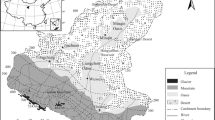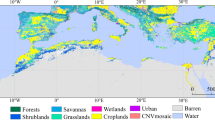Abstract
Traditionally, oasis farmers in hyperarid northern Oman have adapted to the interannual variation of irrigation water supply by dedicating an often sizable proportion of the agricultural area to the production of annual crops and leaving this area uncultivated in drought years. We hypothesized that increases in the share of perennial crops may put long-term hydrological sustainability at risk. To test this hypothesis, we compared agricultural water demand patterns of five oases in the mountain region of Al Jabal al Akhdar for 1978 and 2005. We analyzed land use changes by classifying aerial photographs taken in 2005 and 1978 into five land use types. Water demand in 2005 was estimated based on two GIS-based detailed crop inventories during the hot and cool season and on measurements of temperature, solar radiation and wind speed, from which crop evapotranspiration was calculated using the Penman–Monteith equation. Radiation and wind speed measurements were improved by topographic modeling. Water demand per area was summarized for each land use type and the results used to estimate water demand in 1978. Water supply estimates were based on spring flow measurements. Between 1978 and 2005, agricultural water demand in the study area rose from 218,800 to 256,377 m3 a−1. The most prominent land use changes were the disappearance of non-palm orchards at Masayrat ar Ruwajah and expansions of the area under perennial crops at Al ‘Aqr, Ash Sharayjah and Qasha’ at the expense of field crops. As a consequence, the summer peak of crop water demand decreased at Masayrat ar Ruwajah, where all perennial crops could easily be irrigated with the minimum water supply observed during our study, but this summer peak increased at the other oases. Meeting the water demand of all perennial crops at Qasha’ required average spring flow conditions in 2005, indicating severe water deficiency in drought years. In addition to increased water demand, the oases’ water balance might also be under pressure from reductions in water supply caused by increased extraction of water from the same aquifer by a rapidly growing new town in the area.








Similar content being viewed by others
References
Abdel-Rahman HA, Omezzine A (1996) Aflaj water resources management: tradable water rights to improve irrigation productivity in Oman. Water Int 21:70–75
Abercrombie T (1981) Oman: guardian of the Gulf. Natl Geogr 160:344–377
Allen RG, Pereira LS, Raes D, Smith M (1998) Crop evapotranspiration—guidelines for computing crop water requirements. Food and Agriculture Organization of the United Nations, Rome
ASCE (2005) The ASCE standardized reference evapotranspiration equation. American Society of Civil Engineers, Reston, VA
Bachmann A (1998) Coupling NUATMOS with the GIS ARC/INFO—final report for MINERVE 2. Department of Geography, Division of Spatial Data Handling, University of Zurich, Zurich
Bowling LC, Lettenmaier DP (1997) Evaluation of the effects of forest roads on streamflow in Hard and Ware Creeks, Washington. Water resources series. Department of Civil Engineering, University of Washington, Seattle, WA
Buerkert A, Mahler F, Marschner H (1996) Soil productivity management and plant growth in the Sahel: potential of an aerial monitoring technique. Plant Soil 180:29–38
Costa PM (1983) Notes on traditional hydraulics and agriculture in Oman. World Archaeol 14:273–295
Dorvlo ASS, Ampratwum DB (1998) Summary climatic data for solar technology development in Oman. Renew Energy 14:255–262
FAO (2007) AQUASTAT Database. Food and Agriculture Organization of the United Nations, Rome
Fisher M (1994) Another look at the variability of desert climates, using examples from Oman. Glob Ecol Biogeogr Lett 4:79–87
Garnier M, Zreik L, Bove JM (1991) Witches-Broom, a lethal mycoplasmal disease of lime trees in the Sultanate-of-Oman and the United-Arab-Emirates. Plant Dis 75:546–551
Gebauer J, Luedeling E, Hammer K, Nagieb M, Buerkert A (2007) Mountain oases in northern Oman: an environment for crop evolution and in situ conservation of plant genetic resources. Genet Resour Crop Evol 54:465–481
Glennie K, Boeuf M, Hughes Clarke M, Moody-Stuart M, Pilaar W, Reinhardt B (1974) Geology of the Oman Mountains. Verh K Ned Geol Mijnbouwk Genoot 31:1–423
Hargreaves GH, Samani ZA (1982) Estimating potential evapo-transpiration. J Irr Drain Div-ASCE 108:225–230
Khan IA, Grosser JW (2004) Regeneration and characterization of somatic hybrid plants of Citrus sinensis (sweet orange) and Citrus micrantha, a progenitor species of lime. Euphytica 137:271–278
Korn L, Häser J, Schreiber J, Gangler A, Nagieb A, Siebert S, Buerkert A (2004) Tiwi and Wadi Tiwi: the development of an oasis on the north-eastern coast of Oman. J Oman Stud 13:57–90
Luedeling E, Buerkert A (2008) Typology of mountain oases in Oman based on Landsat and SRTM imagery and geological survey data. Remote Sens Environ, DOI 10.1016/j.rse.2007.08.007
Luedeling E, Nagieb M, Wichern F, Brandt M, Deurer M, Buerkert A (2005) Drainage, salt leaching and physico-chemical properties of irrigated man-made terrace soils in a mountain oasis of northern Oman. Geoderma 125:273–285
Luedeling E, Siebert S, Buerkert A (2007) Filling the voids in the SRTM elevation model—a TIN-based delta surface approach. ISPRS J Photogramm 62:283–294
Nagieb M, Siebert S, Luedeling E, Buerkert A, Häser J (2004) Settlement history of a mountain oasis in northern Oman—evidence from land-use and archaeological studies. Die Erde 135:81–106
Norman WR, Shayya WH, Al-Ghafri AS, McCann IR (1998) Aflaj irrigation and on-farm water management in northern Oman. Irrig Drain 12:35–48
Penman HL (1948) Natural evaporation from open water, bare soil and grass. Proc R Soc Lond A 193:120–145
Priestley CHB, Taylor RJ (1972) Assessment of surface heat-flux and evaporation using large-scale parameters. Mon Weather Rev 100:81–92
Ross DG, Smith IN, Manins PC, Fox DG (1988) Diagnostic wind-field modeling for complex terrain—model development and testing. J Appl Meteorol 27:785–796
Schäper W (2006) Fernrohrbrille und Modellflugzeuge. Innovation 17:52–57
Scholz F (1984) Höhensiedlungen am Jabal Akhdar - Tendenz und Probleme der Entwicklung einer peripheren Region im Oman-Gebirge. Zeit Wirt 28:16–30
Siebert S, Häser J, Nagieb M, Korn L, Buerkert A (2005) Agricultural, architectural and archaeological evidence for the role and ecological adaptation of a scattered mountain oasis in Oman. J Arid Environ 62:177–197
Siebert S, Nagieb M, Buerkert A (2007) Climate and irrigation water use of a mountain oasis in northern Oman. Agric Water Manage 89:1–14
Acknowledgements
We are indebted to Uta Dickhoefer, who provided demographic information on Omani oases and conducted spring flow measurements, to Dr. Wolfgang Schäper for developing and using the equipment for taking aerial photographs from a remotely controlled airplane, to Dr. Jens Gebauer for helping with vegetation mapping and to Prof. Dr. Fred Scholz for making his collection of historical photographs of Oman available to us. We further acknowledge the cooperation of Dr. Andreas Bachmann, who made his version of the NUATMOS wind model available, the Waterworks of Al Jabal al Akhdar of the Ministry of Housing, Electricity and Water for providing water use statistics, the Agricultural Extension Center at Sayh Qatanah for general information about the oases and maintenance of the weather station and Sultan Qaboos University at Muscat for infrastructural support. We also wish to express our gratitude towards the German Research Foundation (DFG) for generous funding (BU 1308).
Author information
Authors and Affiliations
Corresponding author
Additional information
Responsible Editor: Yan Li.
Rights and permissions
About this article
Cite this article
Luedeling, E., Buerkert, A. Effects of land use changes on the hydrological sustainability of mountain oases in northern Oman. Plant Soil 304, 1–20 (2008). https://doi.org/10.1007/s11104-007-9515-y
Received:
Accepted:
Published:
Issue Date:
DOI: https://doi.org/10.1007/s11104-007-9515-y




